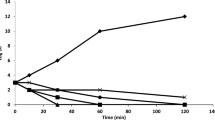Abstract
Acanthamoeba is a free-living amoebae genus that causes amoebic keratitis which is a painful sight-threatening disease of the eyes. Its treatment is difficult, and the search for new drugs is very important. Here, essential oils obtained from the aerial parts of Croton pallidulus, Croton isabelli, and Croton ericoides (Euphorbiaceae), native plants of Southern Brazil, were tested against Acanthamoeba polyphaga and analyzed by gas chromatography and gas chromatography–mass spectrometry. The essential oils of C. pallidulus and C. isabelli were characterized by the presence of sesquiterpenes: germacrene D (15.5 %), terpinen-4-ol (13.2 %), and β-caryophyllene (13.1 %) in C. pallidulus and bicyclogermacrene (48.9 %) in C. isabelli. The essential oil of C. ericoides presented mainly monoterpenes, β-pinene (39.0 %) being the main component. Laboratory tests were carried out to determine the effect of the essential oils against A. polyphaga trophozoites. The essential oil of C. ericoides was the most active, killing 87 % of trophozoites at the concentration of 0.5 mg/mL. The essential oil of C. pallidulus killed only 29 % of the trophozoites at the same concentration. The essential oil of C. isabelli presented the lowest activity, killing only 4 % of the trophozoites at the concentration of 10 mg/mL. The essential oils of the three species showed cytotoxic effect by the methyl thiazolyl tetrazolium (MTT) method in Vero cells. The oil of C. ericoides, which showed the highest amoebicidal activity, was the most cytotoxic on these mammalian cells.



Similar content being viewed by others
References
Adams RP (2001) Identification of essential oil components by gas chromatograph/quadrupole mass spectroscopy. Allured Publishing, Carol Stream
Ajayi AO, Akintola TA (2010) Evaluation of antibacterial activity of some medicinal plants on common enteric food-borne pathogens. Afr J Microbiol Res 4:314–316
Angélico EC (2011) Avaliação das Atividades Antibacteriana e Antioxidante de Croton heliotropiifolius Kunte e Croton blanchetianus Baill. Master Thesis, Universidade de Campinas Grande-PB
Azevedo MMB (2010) Avaliação da atividade antimicrobiana e antioxidante dos óleos essenciais de Croton cajucara Benth e Croton sacaquinha Croizat e obtenção de seus componentes bioativos. Master's thesis, Universidade Federal do Rio de Janeiro
Clardy J, Walsh C (2004) Lesson from natural molecules. Nature 432:829–837
Clarke DW, Niederkorn JY (2006) The immunobiology of Acanthamoeba keratitis. Microbes Infect 8:1400–1405
El-Sayed NM, Ismail KA, Ahmed SA, Hetta MH (2011) In vitro amoebicidal activity of ethanol extracts of Arachis hypogaea L., Curcuma longa L. and Pancratium maritimum L. on Acanthamoeba castellanii cysts. Parasitol Res. doi:10.1007/s00436-011-2727-3
Fortes JC, Guedes MIF (2006) Atividade antimicrobiana do óleo essencial de Croton argyrophylloides Muel. Arg. e de frações isoladas dos extratos de Astronium urundeuva (Allemão) Engl. Anais da 58a reunião Anual da SBPC, Florianópolis-SC
Freitas JVB, Gomes CL, Vieira MGS, Queiroz VA, Neto AC, Gramosa NV (2010) Constituintes químicos voláteis das folhas de Croton muscicapa Müll. Arg. 50º Congresso Brasileiro de Química
Khan NA (2006) Acanthamoeba: biology and increasing importance in human health. FEMS Microbiol Rev 30:564–595
Kliescikova J, Kulda J, Nohynkova E (2011) Propylene glycol and contact-lens solutions containing this diol induce pseudocyst formation in Acanthamoebae. Exp Parasitol 127:326–328
Malatyali E, Tepe B, Degerli S, Berk S, Akpulat HA (2012) In vitro amoebicidal activity of four Peucedanum species on Acanthamoeba castellanii cysts and trophozoites. Parasitol Res 110:167–174
Meccia GLB, Rojas C, Rosquete C, San Feliciano A (2000) Essential oil of Croton ovalifolius Vahl from Venezuela. Flavour Fragr J 15:144–146
Mosmann T (1983) Rapid colorimetric assay for cellular growth and survival: application to proliferation and cytotoxicity assays. J Immunol Methods 65:55–63
Newman DJ (2002) Natural products and derivatives as leads to cell cycle pathway targets in cancer chemotherapy. Curr Cancer Drug Targets 2:279–308
Ródio C, Vianna DR, Kowalski KP, Panatieri LF, von Poser G, Rott MB (2008) In vitro evaluation of the amebicidal activity of Pterocaulon polystachyum (Asteraceae) against trophozoites of Acanthamoeba castellanii. Parasitol Res 104:191–194
Rodriguesa FG, Costa JGM, Coutinho HDM (2009) Synergy effects of antibiotics gentamicin and the essential oil of Croton zehntneri. Phytomedicine 11:1052–1055
Sauter IS, Santos JC, Apel MA, Cibulski SP, Roehe PM, von Poser GL, Rott MB (2011) Amoebicidal activity and chemical composition of Pterocaulon polystachyum (Asteraceae) essential oil. Parasitol Res 5:1367–1371
Scheid P, Zöller L, Pressmar S, Richard G, Michel R (2008) An extraordinary endocytobiont in Acanthamoeba sp. isolated from a patient with keratitis. Parasitol Res 102:945–950
Schuster FL, Visvesvara GS (2004) Free-living amoebae as opportunistic and non-opportunistic pathogens of humans and animals. Int J Parasitol 34:1001–1027
Simionatto E, Bonani VFL, Peres MTLP, Hess SC, Candido ACS, Raimo DL, Poppi NR, Matos MFC, Santos ECS, Oguma PM, De Carvalho JE (2009) Bioactivity and chemical composition of the essential oils of Croton urucurana baillon. J Essent Oil-Bearing Plants 3:250–261
Vieira PRN, Cordeiro R, Brilhante RSN, Moraes SM, Sidrim JJC, Rocha MFG (2007) Avaliação da atividade antifúngica dos óleos essenciais de Croton argyrophylloides e Croton zehntneri frente a cepas de Trichophyton rubrum. 47º Congresso Brasileiro de Química. Natal- RN
Acknowledgments
The authors would like to thank Coordenação de Aperfeiçoamento de Pessoal de Nível Superior (CAPES) and Conselho Nacional de Pesquisa e Desenvolvimento Científico e Tecnológico (CNPq) for financial support, and Dr. Naveed Khan for providing the A. polyphaga strain.
Author information
Authors and Affiliations
Corresponding author
Rights and permissions
About this article
Cite this article
Vunda, S.L.L., Sauter, I.P., Cibulski, S.P. et al. Chemical composition and amoebicidal activity of Croton pallidulus, Croton ericoides, and Croton isabelli(Euphorbiaceae) essential oils. Parasitol Res 111, 961–966 (2012). https://doi.org/10.1007/s00436-012-2918-6
Received:
Accepted:
Published:
Issue Date:
DOI: https://doi.org/10.1007/s00436-012-2918-6




